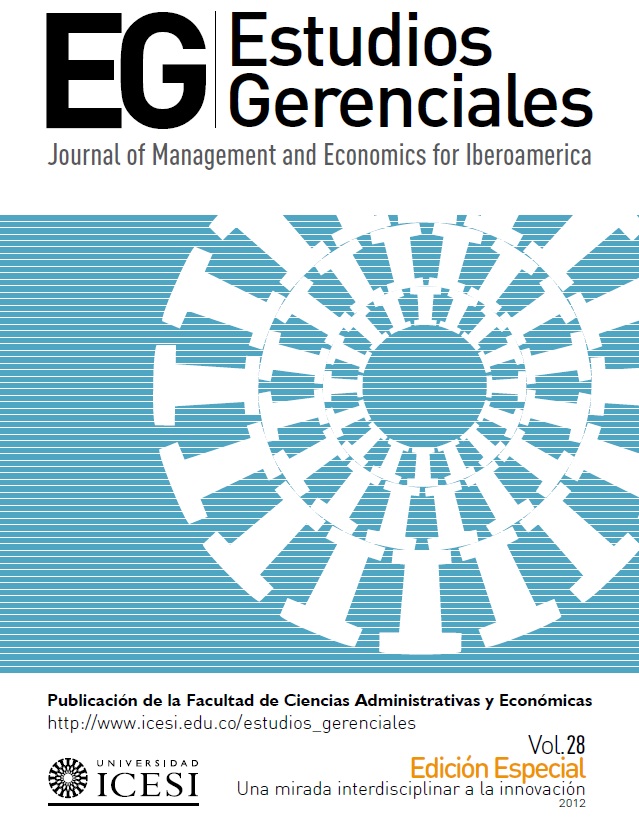¿Hay verdadera innovación en los lanzamientos de nuevos productos? Factores relevantes de éxito y fracaso en el caso colombiano
DOI:
https://doi.org/10.18046/j.estger.2012.1488Keywords:
Innovación, lanzamiento nuevos productos, fracaso de nuevos productos, mejores prácticas lanzamiento de nuevos productosAbstract
El lanzamiento de nuevos productos es determinante para el crecimiento y supervivencia de las organizaciones; sin embargo, su tasa de fracaso es muy alta. El objetivo de la presente investigación exploratoria es evaluar si los ejecutivos en Colombia aplican las mejores prácticas para el lanzamiento de nuevos productos, sus dificultades en implementación y el rol de la innovación en este proceso. A través de entrevistas a altos ejecutivos de mercadeo de doce organizaciones, se encontraron graves deficiencias en el conocimiento de las mejores prácticas.
Downloads
References
Ambert, A., Adler, P.A., Adler, P. & Detzner, D. (1995). Understanding and Evaluating Qualitative Research. Journal of Marriage & Family, 57(4), 879-893.
Booz, Allen, & Hamilton. (1982). New Product Management for the 1980s. New York, NY: Autores.
Brody, A. (1999). Developing New Food Products for a Changing Marketplace. Duluth, MI: CRC Press.
Chandy, R. & Tellis, G.J. (2000). The incumbent's curse? Incumbency, size, and radical product innovation. Research Technology Management, 64(3), 1-17.
Clancy, K. & Shulman, S. (1994). Mitos del marketing que están matando a los negocios. México: McGraw-Hill.
Coffey, A. & Atkinson, P. (2003). Encontrar sentido a los datos cualitativos. Estrategias complementarias de investigación. Medellín, Colombia: Universidad de Antioquia.
Collis, J. & Hussey, R. (2003). Business research (2a ed.). Basingstoke, NH: Palgrave Macmillan.
Cooper, R. (1990). Stage-Gate Systems: A New Tool for managing new Products. Business Horizons, 33(3), 44-54.
Cooper, R. (2006). Formula for Success. Marketing Management Magazine, March/ April, 21-24.
Cooper, R. (2007). Winning business in product development: the critical success factor. Research Technology Management, 50(3), 52-66.
Cooper, R. (2008). Perspective: The Stage- Gate ®Idea-to Launch Process-Update, What's New, and NexGen Systems. Journal of Product Innovation Management, 25(3), 213-232.
Cooper, R. (2009). Effective Gating. Make productive by using gates with teeth. Marketing Management Magazine, March/ April, 12-17.
Cooper, R. & Kleinschmidt, E. (1993). Stage- Gate Systems for New Product Success. Marketing Management Magazine, 1(4), 20-29.
Crawford, M. & Di Benedetto, A. (2003). New Products Management. New York, NY: McGraw-Hill.
Edgett, S. (2007). Portfolio Management: Optimizing for Success. Houston, TX: American Productivity & Quality Center.
Goldenberg, J., Horowitz, R., Levav, A. & Mazursky, D. (2003). Finding your innovation sweet spot. Harvard Business Review, 81(3), 3-10.
Goldenberg, J., Lehmann, D. & Mazursky, D. (2001). The Idea itself and the Circumstances of its Emergence as Predictors of New product Success. Management Science, 47(1), 69-84.
Harwood, T. & Garry, T. (2003). An Overview of Content Analysis. The Marketing Review, 3(4), 479-498.
Hoonsopon, D. & Ruenrom, G. (2009). The Empirical Study of the Impact of Product Innovation Factors on the Performance of New Products: Radical and Incremental Product Innovation. The Business Review, 12(2), 155-161.
Kim, W.C. & Mauborgne, R.A. (2005). Blue Ocean Strategy from theory to practice. California Management Review, 47(3), 105-121.
Kristina, B. & Dean, M. (2005). When is an Invention Really radical? Defining and Measuring Technological Radicalness. Research Policy, 34(5), 717-737.
Kuczmarski, T. (1997). Innovación: estrategias de liderazgo para mercados de alta competencia. Bogotá: McGraw-Hill.
Lincoln, Y. & Guba, E. (1985). Naturalistic inquiry. Beverly Hills, CA: Sage.
Malhotra, N., Davila, J.F. & Treviño, M. (2004). Investigación de Mercados. Un enfoque aplicado. Madrid: Pearson Education.
Mariampolski, H. (2001). Qualitative Market Research. Londres: Sage.
Miller, W. (2006). Innovation Rules!. Research Technology Management, 49(2), 8-14.
Neuendorf, K.A. (2002). The content analysis guidebook. Londres: Sage.
Osorio, C.A. (2010). El arte de fallar. Harvard Business Review, 88(4), 76-85.
Ries, A & Trout, J. (1989). La revolución del marketing: La táctica dicta la estrategia. Bogotá: McGraw-Hill.
Schnarch, A. (2009). Desarrollo de nuevos productos y empresas. Bogotá: McGraw-Hill.
Schumpeter, J. (1978). Teoría del desenvolvimiento económico (5a ed). México. Fondo de Cultura económica.
Senge, P. (1990). The Fifth Discipline: The Art and Practice of the Learning Organization. New York, NY: Doubleday & Company.
Sethi, R., Smith, D.C. & Park, C.W. (2001). Cross-Functional Product Development Teams, creativity, and The Innovativeness of New Consumer Products. Journal of Marketing Research, 38(1), 73-85.
Strauss, A. & Corbin, J. (1990). Basic of qualitative research. Newbury Park, CA: Sage.
Taylor, J. (1983). Como planear estrategias rentables de productos nuevos. New York, NY: Modern Business Reports.
Taylor, S. & Bogdan, R. (1986). Introducción a los métodos cualitativos de investigación: La búsqueda de significados. Buenos Aires: Paidós.
Urban, G.L. & Hauser, J.R. (1980). Design and marketing of new products. New Jersey, NJ: Prentice-Hall.
Ziamou, P. & Ratneshwar, S. (2003). Innovations in Products Functionality: When and Why Are Explicit Comparisons effective?. Journal of Marketing, 67(abril), 49-61.
Downloads
Published
Issue
Section
License
Articles are the sole responsibility of their authors, and will not compromise Icesi’s University principles or policies nor those of the Editorial Board of the journal Estudios Gerenciales. Authors authorize and accept the transfer of all rights to the journal, both for its print and electronic publication. After an article is published, it may be reproduced without previous permission of the author or the journal but the author(s), year, title, volume, number and range of pages of the publication must be mentioned. In addition, Estudios Gerenciales must be mentioned as the source (please, refrain from using Revista Estudios Gerenciales).








